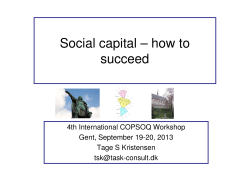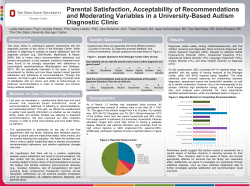
DYADIC ADJUSTMENT SCALE (DAS)
DYADIC ADJUSTMENT SCALE (DAS) Reference: Spanier, G. B. (1976). Measuring dyadic adjustment: New scales for assessing the quality of marriage and similar dyads. Journal of Marriage and the Family, 38, 15–28. Description of Measure: A 32-item measure of relationship quality. The scale is divided into 4 subscales: (1) Dyadic Consensus – degree to which respondent agrees with partner (2) Dyadic Satisfaction -- degree to which respondent feels satisfied with partner (3) Dyadic Cohesion –degree to which respondent and partner participate in activities together (4) Affectional Expression –degree to which respondent agrees with partner regarding emotional affection. Items have varying response scales (see scale below). Abstracts of Selected Related Articles: Graham, J. M., Liu, Y. J., & Jeziorski, J. L. (2006). The Dyadic Adjustment Scale: A reliability generalization meta-analysis. Journal of Marriage and Family, 68, 701717. We conducted a reliability generalization meta-analysis to examine the internal consistency of Dyadic Adjustment Scale (DAS; Spanier, 1976) scores across 91 published studies with 128 samples and 25,035 participants. The DAS was found to produce total and Dyadic cohesion, Consensus, and Satisfaction scores of acceptable internal consistency, although lower than those originally reported by Spanier (1976). Reliability estimates of these scores did not differ by the sexual orientation, gender, marital status, or ethnicity of the sample. The Affective Expression subscale was found to produce scores with poor Cronbach's alpha across studies. Reliability estimates of Affective Expression scores were highly influenced by sample characteristics. The implications of these results are discussed as they relate to the use of the DAS in research. Carey, M. P., Spector, I. P., Lantinga, L. J., & Krauss, D. J. (1993). Reliability of the Dyadic Adjustment Scale. Psychological Assessment, 5, 238-240. Self Report Measures for Love and Compassion Research: General Relationship Satisfaction This study examined the reliability of Spanier's (1976) Dyadic Adjustment Scale (DAS). Middleaged men and women (/V = 158) completed the DAS on 2 occasions separated by approximately 2 weeks. Separate alpha and stability coefficients were calculated for each of the 4 DAS subscales as well as the Total score. Coefficients alpha ranged from .70 (for the 4-item Affectional Expression subscale) to .95 (for the 32-item Total score), Mdn = .87. Stability coefficients ranged from .75 (Affectional Expression) to .87 (Total), Mdn = .81. Partial correlations revealed that the stability of the DAS was not influenced by subjects' age, educational attainment, number of children, relationship duration, or the length of the test-retest interval. These results suggest the DAS and its 4 subscales are internally consistent and stable over the interval examined in this study. Spanier, G. B. & Thompson, L. (1982). A confirmatory factor analysis of the Dyadic Adjustment Scale. Journal of Marriage and Family, 44, 731-738. Evaluated the dyadic adjustment scale by reconsidering the factor structure of the scale and its subscales using a maximum likelihood, confirmatory factor-analysis procedure. Studied a new sample from the same geographical area. High reliability was confirmed for the overall scale. Scale: Contact Multi Health Systems 1-800-456-3003 for permission to use items. Self Report Measures for Love and Compassion Research: General Relationship Satisfaction REVISED DYADIC ADJUSTMENT SCALE (RDAS) Reference: Busby, D. M., Christensen, C., Crane, D. R., & Larson, J. H. (1995). A revision of the Dyadic Adjustment Scale for use with distressed and nondistressed couples: Construct hierarchy and multidimensional scales. Journal of Marital and Family Therapy, 21, 289-308. Description of Measure: A 14-item scale designed to measure relationship satisfaction. The RDAS is a revised version of the original Dyadic Adjustment Scale (Spanier, 1976 –see this website for information on the original). The revised version offers improved psychometric properties, is shorter, and includes only 3 of the original 4 subscales: (1) Dyadic Consensus – degree to which respondent agrees with partner (2) Dyadic Satisfaction -- degree to which respondent feels satisfied with partner (3) Dyadic Cohesion –degree to which respondent and partner participate in activities together The items have varying response scales (see scale below). Abstracts of Selected Related Articles: Spanier, G. B. (1976). Measuring dyadic adjustment: New scales for assessing the quality of marriage and similar dyads. Journal of Marriage and the Family, 38, 15–28. This study reports on the development of the Dyadic Adjustment Scale, a new measure for assessing the quality of marriage and other similar dyads. This factor analytic study suggests four empirically verified components of dyadic adjustment to Self Report Measures for Love and Compassion Research: General Relationship Satisfaction be used as subscales (dyadic satisfaction, dyadic cohesion, dyadic consensus and affectional expression). Treboux, D., Crowell, J. A., & Waters, E. (2004). When “new” meets “old”: Configurations of adult attachment representations and their implications for marital functioning. Developmental Psychology, 40¸295-314. Two studies addressed the implications of concordance versus discrepancy of attachment representations in individuals at 2 stages in their marital relationships. Engaged (n _ 157) and dating (n _ 101) couples participated in a multimethod 6-year longitudinal study of adult attachment. Individuals completed the Adult Attachment Interview (AAI), the Current Relationship Interview (CRI), and various questionnaires and were observed in interactions with partners. On the basis of AAI and CRI classifications, participants were placed in one of four groups: SecureAAI/SecureCRI, SecureAAI/InsecureCRI, InsecureAAI/SecureCRI, or InsecureAAI/InsecureCRI. Each of the configurations showed a particular pattern of behavior, feelings about relationships and the self, and likelihood of relationship breakup. The findings of the studies address important points about the protective effects of attachment security and have interesting implications for the extension of attachment theory into adulthood. Graham, J. M., Liu, Y. J., & Jeziorski, J. L. (2006). The Dyadic Adjustment Scale: A reliability generalization meta-analysis. Journal of Marriage and Family, 68, 701717. We conducted a reliability generalization meta-analysis to examine the internal consistency of Dyadic Adjustment Scale (DAS; Spanier, 1976) scores across 91 published studies with 128 samples and 25,035 participants. The DAS was found to produce total and Dyadic cohesion, Consensus, and Satisfaction scores of acceptable internal consistency, although lower than those originally reported by Spanier (1976). Reliability estimates of these scores did not differ by the sexual orientation, gender, marital status, or ethnicity of the sample. The Affective Expression subscale was found to produce scores with poor Cronbach's alpha across studies. Reliability estimates of Affective Expression scores were highly influenced by sample characteristics. The implications of these results are discussed as they relate to the use of the DAS in research. Scale: Contact Multi Health Systems 1-800-456-3003 for permission to use items. Self Report Measures for Love and Compassion Research: General Relationship Satisfaction INVESTMENT MODEL SCALE (IMS) Reference: Rusbult, C. E., Martz, J. M., and Agnew, C. R. (1998). The Investment Model Scale: Measuring commitment level, satisfaction level, quality of alternatives, and investment size. Personal Relationships, 5, 357-391. Description of Measure: A 29-item scale that measures four constructs of the investment model (Rusbult, 1980 see below for abstract): (1) Commitment level – degree one intends to persist in the relationship (2) Relationship satisfaction – degree that the relationship fulfilled needs for intimacy, sex, companionship, security and emotional involvement. (3) Quality of alternatives – degree that one believes the satisfaction needs (above) could be fulfilled in another relationship. (4) Investment size -- measures perceptions of time invested, interconnected identity, memories, and shared experiences. The Relationship Satisfaction, Quality of Alternatives, and Investment Size components each have Facet Items that are initially asked, prior to more global items. These facet items are concrete exemplars of each construct and are designed to prepare the respondent for the global items and are not measured in final analyses. Respondents answer each item on a 9-point scale ranging from 0 (not at all) to 8 (completely). Here is a diagram of the Investment Model (from Rusbult et al., 1998): Self Report Measures for Love and Compassion Research: General Relationship Satisfaction Abstracts of Selected Related Articles: Rusbult, C. E. (1980a). Commitment and satisfaction in romantic associations: A test of the investment model. Journal of Experimental Social Psychology,16, 172-186 According to the investment model, attraction to and satisfaction with a relationship is a function of a comparison of the relationship outcome value to the individual's expectations, or comparison level. Commitment to a relationship is said to be a function not only of the relationship outcome value, but also the quality of the best available alternative and the magnitude of the individual's investment in the relationship. The investment of resources serves to increase commitment by increasing the costs of leaving the relationship. In Exp I, with 171 undergraduates, commitment to relationships increased with investment size and decreased with the value of alternatives, but was not appreciably affected by relationship costs. Satisfaction/attraction significantly increased as relationship costs decreased. In Exp II, with 111 undergraduates, satisfaction/attraction was predicted by relationship reward value and relationship cost value. Commitment to relationships increased as relationship reward value and investment size increased and as alternative value and relationship cost value decreased, although the effects of cost value were weak. Self Report Measures for Love and Compassion Research: General Relationship Satisfaction Rusbult, C. E. (1983). A longitudinal test of the investment model: The development (and deterioration) of satisfaction and commitment in heterosexual involvements. Journal of Personality and Social Psychology, 45, 101-117. Used a longitudinal study of heterosexual dating relationships to test investment model predictions regarding the process by which satisfaction and commitment develop (or deteriorate) over time. Initially, 17 male and 17 female undergraduates, each of whom was involved in a heterosexual relationship of 0-8 wks duration, participated. Four Ss dropped out, and 10 Ss' relationships ended. Questionnaires were completed by Ss every 17 days. Increases over time in rewards led to corresponding increases in satisfaction, whereas variations in costs did not significantly affect satisfaction. Commitment increased because of increases in satisfaction, declines in the quality of available alternatives, and increases in investment size. Greater rewards also promoted increases in commitment to maintain relationships, whereas changes in costs generally had no impact on commitment. For stayers, rewards increased, costs rose slightly, satisfaction grew, alternative quality declined, investment size increased, and commitment grew; for leavers the reverse occurred. Ss whose partners ended their relationships evidenced entrapment: They showed relatively low increases in satisfaction, but their alternatives declined in quality and they continued to invest heavily in their relationships. Rusbult, C. E., Verette, J., Whitney, G. A,, Slovik. L. F., & Lipkus, I. (1991). Accommodation processes in close relationships: Theory and preliminary empirical evidence. Journal of Personality and Social Psychology, 60, 53-78. A theory of accommodation processes is advanced, and the results of 6 studies are reported. Accommodation refers to the willingness, when a partner has engaged in a potentially destructive act, to inhibit impulses to react destructively and instead react constructively. Studies 1 and 2 demonstrated that accommodation is lower under conditions of reduced social concern and lower interdependence. Studies 3, 4, and 5 revealed that accommodation is associated with greater satisfaction, commitment, investment size, centrality of relationship, psychological femininity, and partner perspective taking and with poorer quality alternatives. Commitment plays a fairly strong role in mediating willingness to accommodate. Study 6 showed that couple functioning is associated with greater joint and mutual tendencies to inhibit destructive reactions. Study 6 also demonstrated that self-reports of accommodation are related to relevant behavioral measures. Scale: Contact author for permission to use items. Self Report Measures for Love and Compassion Research: General Relationship Satisfaction PERSONAL ASSESSMENT OF INTAMACY IN RELATIONSHIPS SCALE Reference: Schaefer, M. T. & Olson, D. H. (1981) Assessing intimacy: The PAIR Inventory, Journal of Marital and Family Therapy, 1, 47-60. Description of Measure: A 36-item measure of relationship intimacy, encompassing five different factors and one “faking” scale. The five factors are: (1) Emotional Intimacy – feeling closeness, ability to share feelings, and be supported without defensiveness. (2) Social Intimacy – having common friends and social network. (3) Sexual Intimacy – sharing affection, touching, physical and sexual closeness. (4) Intellectual Intimacy – sharing ideas and experiences about life and work. (5) Recreational Intimacy – sharing of experiences, common pastimes and involvement in activities. The scale can either be phrased in terms of how the relationship “is now” or it can be phrased in terms of how the relationship “should be” (or both), depending on what the researcher wishes to study. Respondents answer each item on a 5-point scale ranging from 1 (strongly disagree) to 5 (strongly agree). Abstracts of Selected Related Articles: Self Report Measures for Love and Compassion Research: General Relationship Satisfaction Moore, K. A., McCabe, M. P., & Stockdale, J. E. (1998). Factor analysis of the Personal Assessment of Intimacy in Relationships Scale (PAIR): Engagement communication and shared friendships. Sexual and Relational Therapy, 13, 361-368. The Personal Assessment of Intimacy in Relationships (PAIR) was developed by Schaefer & Olson (1981) to assess both the actual and ideal levels of intimacy in relationships. Attempts to replicate the original factor structure have not been reported. In Stage 1 of the present study, 157 volunteers (34 males, 123 females; mean age 27.76 years) who were currently in committed relationships completed the PAIR. Factor analysis failed to replicate the original structure but yielded a reliable, independent three-factor solution: engagement, communication and shared friendships. There were no gender differences on these factors. Confirmatory factor analysis failed to confirm this three-factor solution in a group of 145 clients (77 males, 68 females; mean age 35.79 years) presenting to a clinic for the treatment of sexual dysfunction. Principal components analysis yielded a unifactorial solution. These results suggest that people from the general population demonstrate three independent but increasingly involved aspects of intimacy, ranging from engagement to communication to shared friendships. People with sexual dysfunction seem to experience a decrement in all aspects of intimacy. The implications of these findings for the treatment of sexual dysfunction are discussed. Gable, S. L., Reis, H. T., Impett, E. A., & Asher, E. R. (2004). What do you do when things go right? The intrapersonal and interpersonal benefits of sharing positive events. Journal of Personality and Social Psychology, 87, 228-245. Four studies examined the intrapersonal and interpersonal consequences of seeking out others when good things happen (i.e., capitalization). Two studies showed that communicating personal positive events with others was associated with increased daily positive affect and well-being, above and beyond the impact of the positive event itself and other daily events. Moreover, when others were perceived to respond actively and constructively (and not passively or destructively) to capitalization attempts, the benefits were further enhanced. Two studies found that close relationships in which one’s partner typically responds to capitalization attempts enthusiastically were associated with higher relationship well-being (e.g., intimacy, daily marital satisfaction). The results are discussed in terms of the theoretical and empirical importance of understanding how people “cope” with positive events, cultivate positive emotions, and enhance social bonds. Self Report Measures for Love and Compassion Research: General Relationship Satisfaction Reis, H. T. & Franks, P. (2005). The role of intimacy and social support in health outcomes: Two processes or one? Personal Relationships, 1, 185-197. That intimacy and social support are related to an individual's health and well-being has often been noted. The present study had two goals. First, we intended to establish whether intimacy and social support were related to mental and physical health in a large, representative community sample. Second, we sought to determine whether intimacy and social support make unique contributions to predicting health, as a step toward developing a model of the relation between these processes. Results strongly supported the initial hypothesis that intimacy and social support were both related to health status. We also found that the effects of intimacy on well-being were mediated by social support, but that the effects of social support were not mediated by intimacy. We therefore concluded that the health-promoting benefits of intimacy most likely occur because intimate relationships are likely to engender higher levels of social support. Distinguishing unique and shared prediction effects is a generic concern for disciplines that study variables that are naturally correlated in real life, such as in the field of personal relationships. Scale: Contact Dr. Olson for permission to use items. Self Report Measures for Love and Compassion Research: General Relationship Satisfaction RELATIONSHIP ASSESSMENT SCALE Reference: Hendrick, S. S. (1988). A generic measure of relationship satisfaction. Journal of Marriage and the Family, 50, 93–98. Description of Measure: A 7-item scale designed to measure general relationship satisfaction. Respondents answer each item using a 5-point scale ranging from 1 (low satisfaction) to 5 (high satisfaction). Abstracts of Selected Related Articles: Aron, A., Norman, C. C., Aron, E. N., McKenna, C., & Heyman, R. E.(2000). Couples’ shared participation in novel and arousing activities and experienced relationship quality. Journal of Personality and Social Psychology, 78, 273-284. Using a newspaper questionnaire, a door-to-door survey, and 3 laboratory experiments, the authors examined a proposed effect of shared participation in novel and arousing activities on experienced relationship quality. The questionnaire and survey studies found predicted correlations of reported shared "exciting" activities and relationship satisfaction plus their predicted mediation by relationship boredom. In all 3 experiments, the authors found predicted greater increases in experienced relationship quality from before to after participating together in a 7min novel and arousing (vs. a more mundane) task. Comparison with a no-activity control showed the effect was due to the novel-arousing task. The same effect was found on ratings of videotaped discussions before and after the experimental task. Finally, all results remained after controlling for relationship social desirability. Results bear on general issues of boredom and excitement in relationships and the role of such processes in understanding the typical early decline of relationship quality after the honeymoon period. Self Report Measures for Love and Compassion Research: General Relationship Satisfaction Gable, S. L., Reis, H. T., Impett, E. A., & Asher, E. R. (2004). What do you do when things go right? The intrapersonal and interpersonal benefits of sharing positive events. Journal of Personality and Social Psychology, 87, 228-245. Four studies examined the intrapersonal and interpersonal consequences of seeking out others when good things happen (i.e., capitalization). Two studies showed that communicating personal positive events with others was associated with increased daily positive affect and well-being, above and beyond the impact of the positive event itself and other daily events. Moreover, when others were perceived to respond actively and constructively (and not passively or destructively) to capitalization attempts, the benefits were further enhanced. Two studies found that close relationships in which one’s partner typically responds to capitalization attempts enthusiastically were associated with higher relationship well-being (e.g., intimacy, daily marital satisfaction). The results are discussed in terms of the theoretical and empirical importance of understanding how people “cope” with positive events, cultivate positive emotions, and enhance social bonds. Funk, J. L. & Rogge, R. D. (2007). Testing the ruler with item response theory: Increasing precision of measurement for relationship satisfaction with the Couples Satisfaction Index. Journal of Family Psychology, 21, 572-583. The present study took a critical look at a central construct in couples research: relationship satisfaction. Eight well-validated self-report measures of relationship satisfaction, including the Marital Adjustment Test (MAT; H. J. Locke & K. M. Wallace, 1959), the Dyadic Adjustment Scale (DAS; G. B. Spanier, 1976), and an additional 75 potential satisfaction items, were given to 5,315 online participants. Using item response theory, the authors demonstrated that the MAT and DAS provided relatively poor levels of precision in assessing satisfaction, particularly given the length of those scales. Principal-components analysis and item response theory applied to the larger item pool were used to develop the Couples Satisfaction Index (CSI) scales. Compared with the MAS and the DAS, the CSI scales were shown to have higher precision of measurement (less noise) and correspondingly greater power for detecting differences in levels of satisfaction. The CSI scales demonstrated strong convergent validity with other measures of satisfaction and excellent construct validity with anchor scales from the nomological net surrounding satisfaction, suggesting that they assess the same theoretical construct as do prior scales. Implications for research are discussed. Self Report Measures for Love and Compassion Research: General Relationship Satisfaction Scale: Low High 1. How well does your partner meet your needs? 1 2 3 4 5 2. In general, how satisfied are you with your relationship? 1 2 3 4 5 3. How good is your relationship compared to most? 1 2 3 4 5 4. How often do you wish you hadn’t gotten into this relationship? 1 2 3 4 5 5. To what extent has your relationship met your original expectations? 1 2 3 4 5 6. How much do you love your partner? 1 2 3 4 5 7. How many problems are there in your relationship? 1 2 3 4 5 Scoring: Items 4 and 7 are reverse-scored. Scoring is kept continuous. The higher the score, the more satisfied the respondent is with his/her relationship. Self Report Measures for Love and Compassion Research: General Relationship Satisfaction
© Copyright 2025









